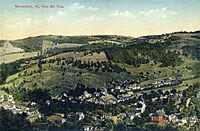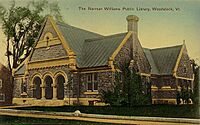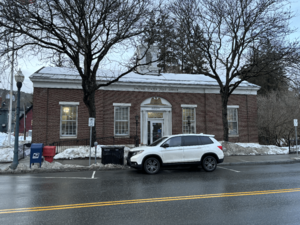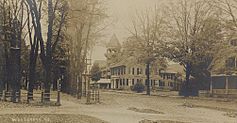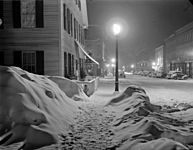Woodstock, Vermont facts for kids
Quick facts for kids
Woodstock, Vermont
|
|
|---|---|

(2010)
|
|
| Motto(s):
We are one.
|
|
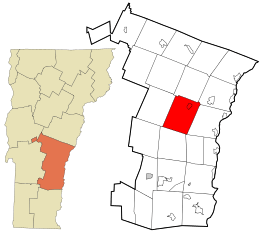
Location in Windsor County and the state of Vermont.
|
|
| Country | United States |
| State | Vermont |
| County | Windsor |
| Chartered | 1761 |
| Communities |
|
| Area | |
| • Total | 44.6 sq mi (115.6 km2) |
| • Land | 44.4 sq mi (114.9 km2) |
| • Water | 0.3 sq mi (0.7 km2) |
| Elevation | 702 ft (214 m) |
| Population
(2020)
|
|
| • Total | 3,005 |
| • Density | 67.33/sq mi (25.995/km2) |
| Time zone | UTC-5 (Eastern (EST)) |
| • Summer (DST) | UTC-4 (EDT) |
| ZIP Codes | |
| Area code(s) | 802 |
| FIPS code | 50-85975 |
| GNIS feature ID | 1462272 |
Woodstock is a charming town in Vermont, United States. It is the main town, also called the county seat, for Windsor County. In 2020, about 3,005 people lived here. The town includes smaller communities like Woodstock village, South Woodstock, Taftsville, and West Woodstock.
Contents
History of Woodstock
Early Days and Growth
Woodstock was officially started on July 10, 1761. New Hampshire Governor Benning Wentworth gave the land to David Page and 61 other people. The town was named after Woodstock in England. This was to honor Blenheim Palace and its owner, George Spencer, 4th Duke of Marlborough.
The first family to settle here was James Sanderson's in 1768. In 1776, Joab Hoisington built a gristmill (for grinding grain) and a sawmill (for cutting wood). These mills were built on the south branch of the Ottauquechee River. Woodstock became an official town in 1837.
Woodstock's Development
The American Revolutionary War slowed down new settlers. But after the war ended in 1783, Woodstock grew quickly. The government of Vermont even met here in 1807. They later moved the capital to Montpelier.
The Ottauquechee River had waterfalls that powered many mills. Factories in Woodstock made tools like scythes and axes. They also made machines for carding wool and produced woolen goods. There were shops for machines and guns. People also made furniture, wooden items, windows, and blinds. Carriages, horse harnesses, and leather goods were also made. By 1859, the town had over 3,000 people.
The Woodstock Railroad opened in 1875. It connected Woodstock to White River Junction. This train carried goods and visitors. The famous Woodstock Inn first opened its doors in 1892.
Modern Woodstock
The Industrial Revolution helped Woodstock become a wealthy town. Today, tourism is a very important part of the town's economy. Many visitors come to see its beautiful old buildings.
Woodstock is known for its lovely central square, called the Green. Around the Green, you can see many old houses. These homes are built in styles like Georgian, Federal Style, and Greek Revival. The cost of homes near the Green is very high. Many wealthy people from cities like Boston and New York own second homes here. This helps the town's economy.
The town also offers free community Wi-Fi internet service. It covers most of Woodstock village and is called "Wireless Woodstock."
-
Woodstock village from Mount Tom in 1913
Town Layout and Design
The way Woodstock is designed is quite special. An author named Witold Rybczynski studied how the town was planned. He found that the town's shape was guided by the land itself.
How Woodstock Was Planned
The town is in a narrow, flat valley. The Ottauquechee River curves around one side, and a small creek is on the other. The town's main green space was placed along this narrow strip of land. This allowed many homes to have gardens that went down to the river.
The people who built Woodstock knew that important buildings needed important spots. For example, the Episcopalian church is at the top of the green. Other churches are placed to create nice views. Private homes, the courthouse, and a hotel share the main spots on the green. Shops and businesses are on streets next to the green, but not directly on it.
This way of designing the town was not from a strict master plan. Instead, it grew naturally as buildings were added. It was like a "very restrained jazz" where builders improvised but followed some unwritten rules.
Informal Building Rules
Some of these unwritten rules included:
- Businesses were built close to the sidewalk.
- Homes were set back about 10 to 14 feet from the sidewalk.
- Plots of land were usually deep and narrow. This kept the street views similar.
- Commercial buildings stood side by side.
- Important public buildings, like the library or courthouse, stood alone.
Woodstock did not have strict zoning laws for a long time. This meant that buildings with different uses, like homes and shops, could be next to each other.
Rockefeller Family's Impact
The Rockefellers had a big impact on Woodstock's look. They helped keep the 19th-century style of the buildings. They also helped protect the town's rural feel.
In the late 1960s, Laurance and Mary French Rockefeller rebuilt the Woodstock Inn. They also had the power lines in the village buried underground. To protect the beautiful views from the hills, the town created a "Scenic Ridgeline District." This rule helps keep the town's natural beauty safe.
Woodstock has been called "The Prettiest Small Town in America" by Ladies Home Journal magazine. In 2011, some of its streets won an award for great street design.
Geography and Climate
Location and Rivers
Woodstock covers about 115.6 square kilometers (44.6 square miles). Most of this is land, with a small amount of water. The Ottauquechee River flows right through the town.
Travel and Nearby Towns
Major roads like U.S. Route 4, Vermont Route 12, and Vermont Route 106 cross Woodstock. While Interstate 89 doesn't go through the town, you can reach it easily from nearby Quechee.
Woodstock is surrounded by other towns: Pomfret to the north, Hartford to the northeast, Hartland to the east, Reading to the south, and Bridgewater to the west.
It's about a three-hour drive from Boston and 250 miles from New York City. You can get there by car or by flying to airports in Rutland or Lebanon. There's also a bus service that stops in Woodstock.
Woodstock's Climate
Woodstock has a humid continental climate. This means it has big changes in temperature throughout the year. Summers are warm to hot, and often humid. Winters are cold, sometimes very cold.
| Climate data for Woodstock, Vermont (1991–2020 normals, extremes 1892–present) | |||||||||||||
|---|---|---|---|---|---|---|---|---|---|---|---|---|---|
| Month | Jan | Feb | Mar | Apr | May | Jun | Jul | Aug | Sep | Oct | Nov | Dec | Year |
| Record high °F (°C) | 67 (19) |
66 (19) |
83 (28) |
93 (34) |
95 (35) |
99 (37) |
104 (40) |
100 (38) |
96 (36) |
88 (31) |
80 (27) |
71 (22) |
104 (40) |
| Mean maximum °F (°C) | 49 (9) |
51 (11) |
61 (16) |
79 (26) |
87 (31) |
91 (33) |
92 (33) |
91 (33) |
87 (31) |
78 (26) |
67 (19) |
53 (12) |
94 (34) |
| Mean daily maximum °F (°C) | 29.5 (−1.4) |
32.8 (0.4) |
41.0 (5.0) |
55.0 (12.8) |
68.1 (20.1) |
76.9 (24.9) |
81.6 (27.6) |
80.1 (26.7) |
73.0 (22.8) |
59.2 (15.1) |
46.4 (8.0) |
35.2 (1.8) |
56.6 (13.7) |
| Daily mean °F (°C) | 18.4 (−7.6) |
20.7 (−6.3) |
29.9 (−1.2) |
43.2 (6.2) |
55.4 (13.0) |
64.8 (18.2) |
69.5 (20.8) |
67.7 (19.8) |
60.2 (15.7) |
47.4 (8.6) |
36.2 (2.3) |
25.4 (−3.7) |
44.9 (7.2) |
| Mean daily minimum °F (°C) | 7.3 (−13.7) |
8.5 (−13.1) |
18.7 (−7.4) |
31.4 (−0.3) |
42.7 (5.9) |
52.6 (11.4) |
57.4 (14.1) |
55.4 (13.0) |
47.3 (8.5) |
35.5 (1.9) |
26.1 (−3.3) |
15.6 (−9.1) |
33.2 (0.7) |
| Mean minimum °F (°C) | −15 (−26) |
−12 (−24) |
−3 (−19) |
19 (−7) |
29 (−2) |
38 (3) |
46 (8) |
44 (7) |
33 (1) |
23 (−5) |
12 (−11) |
−4 (−20) |
−18 (−28) |
| Record low °F (°C) | −38 (−39) |
−43 (−42) |
−27 (−33) |
2 (−17) |
17 (−8) |
29 (−2) |
35 (2) |
29 (−2) |
19 (−7) |
9 (−13) |
−16 (−27) |
−38 (−39) |
−43 (−42) |
| Average precipitation inches (mm) | 2.85 (72) |
2.65 (67) |
3.19 (81) |
3.50 (89) |
3.61 (92) |
4.11 (104) |
3.92 (100) |
3.68 (93) |
3.59 (91) |
4.57 (116) |
3.59 (91) |
3.19 (81) |
42.45 (1,078) |
| Average extreme snow depth inches (cm) | 12 (30) |
16 (41) |
13 (33) |
4 (10) |
0 (0) |
0 (0) |
0 (0) |
0 (0) |
0 (0) |
1 (2.5) |
3 (7.6) |
11 (28) |
19 (48) |
| Source: NOAA | |||||||||||||
People of Woodstock
| Historical population | |||
|---|---|---|---|
| Census | Pop. | %± | |
| 1790 | 1,605 | — | |
| 1800 | 2,132 | 32.8% | |
| 1810 | 2,672 | 25.3% | |
| 1820 | 2,610 | −2.3% | |
| 1830 | 3,044 | 16.6% | |
| 1840 | 3,315 | 8.9% | |
| 1850 | 3,041 | −8.3% | |
| 1860 | 3,062 | 0.7% | |
| 1870 | 2,910 | −5.0% | |
| 1880 | 2,815 | −3.3% | |
| 1890 | 2,545 | −9.6% | |
| 1900 | 2,557 | 0.5% | |
| 1910 | 2,545 | −0.5% | |
| 1920 | 2,370 | −6.9% | |
| 1930 | 2,469 | 4.2% | |
| 1940 | 2,512 | 1.7% | |
| 1950 | 2,613 | 4.0% | |
| 1960 | 2,786 | 6.6% | |
| 1970 | 2,608 | −6.4% | |
| 1980 | 3,214 | 23.2% | |
| 1990 | 3,212 | −0.1% | |
| 2000 | 3,232 | 0.6% | |
| 2010 | 3,048 | −5.7% | |
| 2020 | 3,005 | −1.4% | |
| U.S. Decennial Census | |||
In 2010, Woodstock had 3,048 people living in 1,388 households. About 26.4% of these households had children under 18. The average age in town was 45 years old.
Arts and Culture in Woodstock
Fun Events All Year
- Bookstock Festival: Every June, Woodstock hosts a literary festival called Bookstock. It takes place around the central village green. Famous authors and poets from the area and around the world come to share their work.
- Harvest Weekend: In October, the Billings Farm & Museum holds its annual Harvest Weekend. You can enjoy old-fashioned harvest activities and a barn dance.
- Wassail Weekend: Early in December, the town celebrates Wassail Weekend.
Popular Tourist Spots
- Billings Farm & Museum: This is a popular place to visit. It was once owned by Laurance Rockefeller and his wife Mary French Rockefeller. It's a working dairy farm and has a restored 1890 farmhouse. You can learn about farm life from the past.
- F. H. Gillingham & Sons: This is a historic general store that opened in 1886. It's still in its original building on Elm Street and is a fun place to explore.
Parks and Outdoor Fun
- Marsh-Billings-Rockefeller National Historical Park: This special park is in Woodstock. It's the only National Park System site in Vermont (besides the Appalachian Trail). The park protects the land where Frederick Billings created a managed forest and a modern dairy farm. It's a great place to learn about nature and conservation.
Education in Woodstock
Woodstock has several schools for students. These include Woodstock Elementary School, The Prosper Valley School, and Woodstock Union High School & Middle School. All these schools are part of the Windsor Central Supervisory Union.
Famous People from Woodstock
Many notable people have lived in or are connected to Woodstock:
- Fred C. Ainsworth, a U.S. Army surgeon
- Ivan Albright, a well-known artist
- Franklin S. Billings, a former Governor of Vermont
- Frederick H. Billings, a lawyer and financier
- Keegan Bradley, a professional golfer
- Jacob Collamer, a politician
- George Dewey, an admiral
- Laurance Rockefeller, a businessman and conservationist who helped shape Woodstock
- Otis Skinner, a famous actor
- Gwen Verdon, a talented dancer and actress
- Peter T. Washburn, another former Governor of Vermont
- Paul Watson, a conservationist and TV star
- Daphne Zuniga, a film and television actress
Places to Visit
- Billings Farm & Museum
- Lincoln Covered Bridge (built in 1877)
- Marsh-Billings-Rockefeller National Historical Park
- F. H. Gillingham & Sons (historic general store)
- Middle Covered Bridge (built in 1969)
- Taftsville Covered Bridge (built in 1836)
- First Congregational Church of Woodstock, Vermont
- Town Hall Theatre
- Woodstock Historical Society & Dana House Museum
|
See also
 In Spanish: Woodstock (Vermont) para niños
In Spanish: Woodstock (Vermont) para niños



